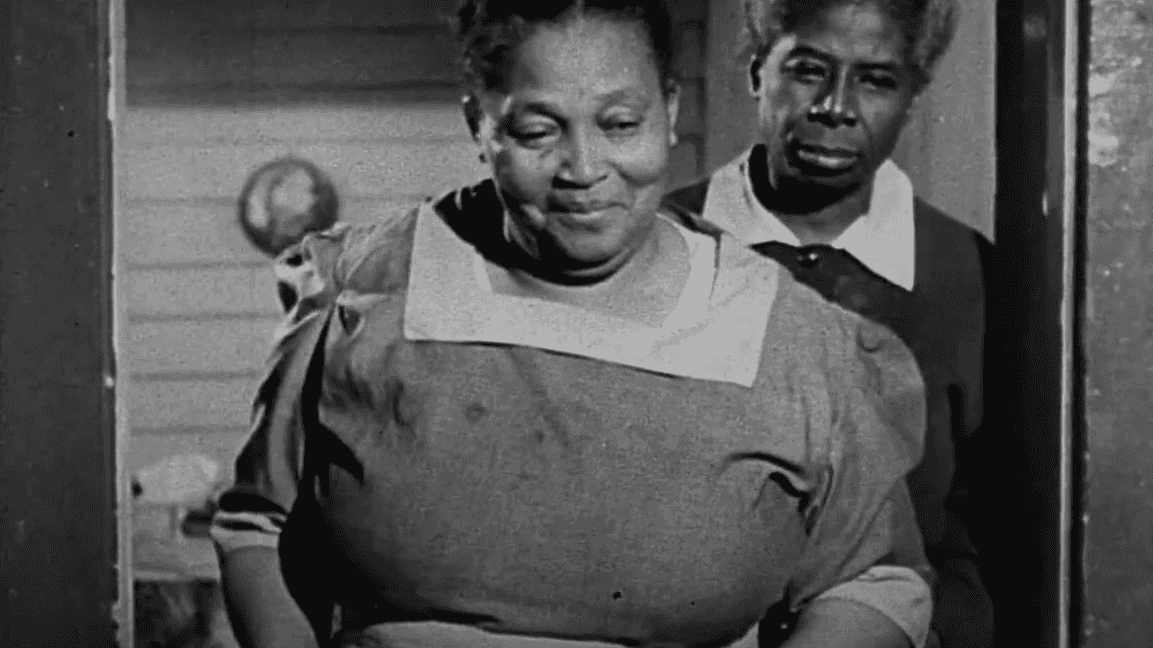Midwives: Tradition and Transition
For generations, midwives provided care for Black communities, but discriminatory laws and restrictions forced them out of the profession.
Caring for the Community
Midwife Standing Next to a Woman in Bed, Greenville, Mississippi, ca. 1950
Midwives traditionally occupied a prominent position in African American communities, serving as healers and spiritual leaders and maintaining extensive social networks. Even after modern medicine moved childbirth from the home to the hospital, women in southern rural communities continued to rely on midwives into the mid-1900s.
Mary Frances Hill Coley: All My Babies
Untitled (Timing Contractions), 1952
Untitled (Next Day Continuing Care), 1952
Mary Frances Hill Coley, a midwife in Albany, Georgia, who had delivered over 3,000 babies, narrated and starred in the 1952 documentary All My Babies. Produced as a training tool by the Georgia Department of Health, the film demonstrated how a well-trained lay midwife could deliver healthy babies even in the poorest conditions. Filmmaker George C. Stoney and set photographer Robert Galbraith depicted Coley interacting with actual patients as well as nurses, physicians, and members of the local community.
Featured Video
"All My Babies: A Midwife’s Own Story"
Excerpts from "All My Babies: A Midwife’s Own Story," a 1952 educational film featuring Mary Frances Hill Coley, a midwife in rural Georgia.
Maude Callen: Nurse Midwife
Untitled (Maude Callen Walking through Mud), 1951
Registered nurse and midwife Maude Callen (1898–1990) served the rural community of Pineville, South Carolina, for over four decades. A graduate of Florida A&M College for Negroes (now Florida A&M University), Callen studied nursing at Homer G. Phillips Hospital in St. Louis and midwifery at Tuskegee Institute in Alabama. In Pineville, she established medical clinics and trained lay midwives in modern techniques. In December 1951, Life magazine featured Callen in a photo essay by W. Eugene Smith.
My mother encouraged me to go around with her, she wanted a midwife always to stay in the family.
Amanda Carey Carter, daughter of midwife Susie Carey
Susie Carey and Amanda Carey Carter: From Mother to Daughter
Photograph of Midwife Susie Carey, 1930s
Photograph of Midwife Amanda Carey Carter, 1970s
Traditionally, midwifery was a profession passed down through families. Amanda Carey Carter (1909–2007) of Prince Edward County, Virginia, was a fourth-generation midwife. Her mother, Susie Carey (1879–1953), worked as a midwife during the era when the profession first became subject to state health regulations. Amanda Carter received her permit to practice midwifery in the 1950s, and she delivered hundreds of babies, Black and white, throughout the region of central Virginia until she retired in 1987.
The careers of Susie Carey and Amanda Carter spanned a time of significant change for midwives in Virginia. In 1918, when the state passed its first law regulating midwives, there were an estimated 9,000 lay (non-nurse) midwives practicing in Virginia. In the 1950s, when Carey retired, approximately 1,000 midwives remained in practice. By the 1980s, when Carter retired, the number of registered lay midwives had dwindled to about 100.
Midwife’s Certificate of Retirement for Susie Carey, 1952
Midwife’s Certificate of Retirement for Amanda Carter, 1987
She would get calls in the middle of the night. . . . She would put on her white uniform and white shoes, and out she would go.
Fannie Mae Carter Silver, daughter of midwife Amanda Carter
Midwife’s Uniform Dress Worn by Amanda Carter, 1960s–70s
Regulation and Restriction
Midwife’s Permit Issued to Amanda Carter, 1955
Certificate of Examination Card, 1960s
During the 20th century, midwives faced increasing restrictions on how they could practice their profession. States passed laws that required midwives to be formally trained and certified as “suitable” by local health officials and physicians. Eventually, the practice of midwifery was restricted to registered nurses, or certified nurse midwives, who were required to work under a doctor’s supervision.
These regulations, in part fueled by the white medical establishment’s prejudiced views of Black and immigrant midwives, effectively eliminated the traditional lay midwife, the occupation of non-nurse midwives such as Susie Carey and Amanda Carter. Black women were also often excluded from professional nurse-midwife training programs, which privileged white applicants. As a result, the number of Black midwives in the U.S. declined dramatically, accounting for no more than 10% of all American certified midwives by the 2010s.
Reclaiming the Legacy
In the 21st century, African Americans continue to suffer from serious racial disparities in maternal health care. Black women in the U.S. are three to four times more likely to die of childbirth complications than white women. To address this crisis, many social justice activists are advocating for the role of Black midwives as part of a culturally congruent, holistic, and equitable model of reproductive health care for Black women. At the local, state, and national level, birth care organizations and providers are leading efforts to increase the number of Black midwives through training, mentorship, and professional support. In reclaiming the legacy of midwifery, these contemporary birth workers are upholding a tradition of healing while also challenging a health care system that has long underserved and mistreated Black communities.
Learn more about the historical significance and modern roles of midwives and doulas and read an interview with three modern-day doulas discussing their profession.
